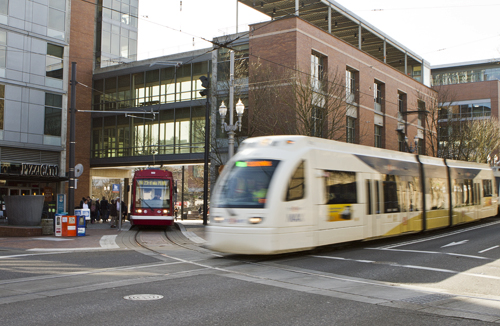
“blackout area.” Photo by Karl Kuchs.
Last week it was reported that the electronic system used to monitor and control light rail activity has a “blackout area” where MAX trains and the Portland Streetcar intersect at Portland State’s Urban Plaza.
The problem, said Bruce Hansen, president of the Amalgamated Transit Union, is that the control monitors are unable to track the trains in the area where the two rail systems intersect.
“Operators can’t see either vehicle,” Hansen said. “Controllers wouldn’t know about a collision or incident until after the fact, when someone called them.”
The source of the problem is unknown, but investigations are currently underway. There are similar blackout zones at Southwest 11th Avenue and Morrison Street, and at Southwest 11th Avenue and Yamhill Street.
Despite the fact the MAX and the streetcar have been crossing paths at PSU and in the downtown area for quite some time, Hansen said the problem has just now been brought to light.
“If I’m so intrigued, why isn’t TriMet?” Hansen asked.
This story comes amid other safety concerns surrounding public transportation and underlines a struggle between TriMet and the ATU.
The news of the blackout zone follows concerns about the safety of TriMet’s buses and rail systems. A recent YouTube video revealed a MAX train traveling down Interstate 84 at highway speeds with its doors open.
Addressing these concerns, the ATU issued a statement that said, “TriMet workers say that open doors on traveling trains are just the tip of the iceberg…Management has been alerted repeatedly to dangerous problems on the light rail system, yet has failed to take action.”
Hansen is quoted in the document expressing concern for worker and public safety. “Our workers are afraid that a passenger, a member of the public or one of their co-workers is going to be injured or killed. It’s that simple.”
The statement also indicated that transit workers have provided a list of railcar doors “seriously in need of an overhaul.
“The mechanics are worried about the serious damage that could occur if one of these 90-pound doors falls, especially if it happens when the train is moving,” Hansen said in the statement. “Anyone can look at the Type 2 and 3 cars and see that the doors are sagging. That’s a clear sign of potential failure.”
Roberta Altstadt, a spokeswoman for TriMet, issued a response to KOIN news refuting these claims.
“As part of an ongoing campaign to discredit TriMet, the ATU alleged that the MAX system is unsafe. These allegations questioning the safety of the MAX system are absolutely false.
“The allegations are meant to deflect attention from contract negotiations.
“TriMet has repeatedly asked the ATU leadership to come to the table to negotiate excessive health care costs and other contract loopholes. They have refused to do so.
“TriMet’s dedicated safety team and union mechanics, operators, controllers and field staff work every day to ensure the system—both bus and MAX—is safe for TM riders and their fellow employees,” Altstadt said.
Regardless of the circumstances, Hansen said the ATU is dedicated to making TriMet and the public aware of safety issues so they can both practice proper safety procedures.
“We’re willing to educate,” Hansen said. “It’s about moving forward.”
The Amalgamated Transit Union has created a website, transitvoice.org, where commuters and citizens can stay updated on the issues and voice their concerns.

